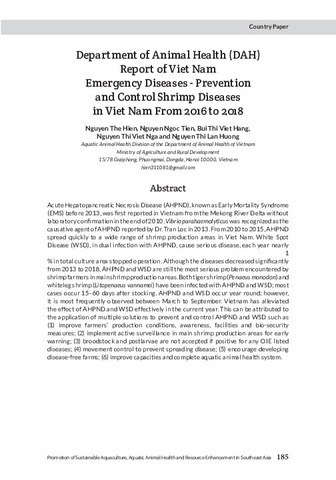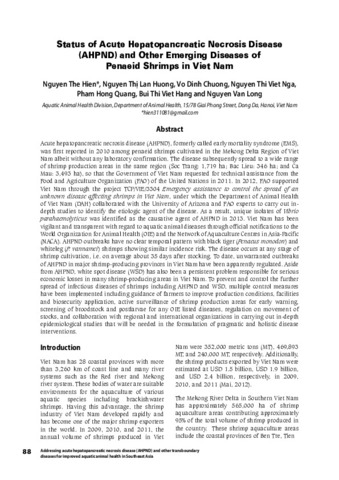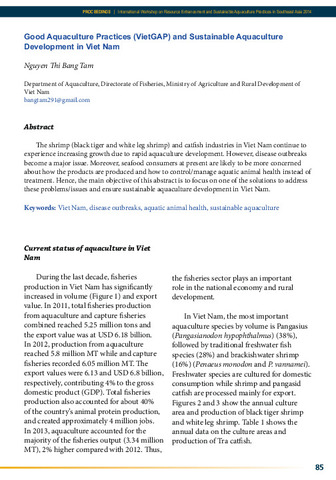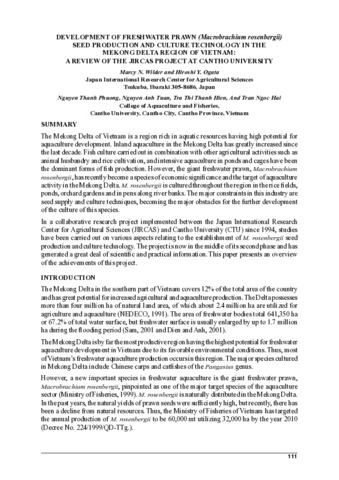Department of Animal Health (DAH) report of emergency diseases - prevention and control of shrimp diseases in from 2016 to 2018
| dc.contributor.author | Hien, Nguyen The | |
| dc.contributor.author | Tien, Nguyen Ngoc | |
| dc.contributor.author | Hang, Bui Thi Viet | |
| dc.contributor.author | Nga, Nguyen Thi Viet | |
| dc.contributor.author | Huong, Nguyen Thi Lan | |
| dc.contributor.editor | Aya, Frolan A. | |
| dc.contributor.editor | de la Peña, Leobert D. | |
| dc.contributor.editor | Salayo, Nerissa D. | |
| dc.contributor.editor | Tendencia, Eleonor A. | |
| dc.date.accessioned | 2021-12-16T03:46:27Z | |
| dc.date.available | 2021-12-16T03:46:27Z | |
| dc.date.issued | 2021-12 | |
| dc.identifier.citation | Hien, N. T., Tien, N. N., Hang, B. T. V., Nga, N. T. V., & Huong, N. T. L. (2021). Department of Animal Health (DAH) report of emergency diseases—Prevention and control of shrimp diseases in from 2016 to 2018. In F. A. Aya, L. D. de la Peña, N. D. Salayo, & E. A. Tendencia (Eds.), Proceedings of the International Workshop on the Promotion of Sustainable Aquaculture, Aquatic Animal Health, and Resource Enhancement in Southeast Asia (pp. 185–199). Tigbauan, Iloilo, Philippines: Aquaculture Department, Southeast Asian Fisheries Development Center. | en |
| dc.identifier.isbn | 9789719931102 (Print) | |
| dc.identifier.isbn | 9789719931119 (PDF) | |
| dc.identifier.uri | http://hdl.handle.net/10862/6272 | |
| dc.description.abstract | Acute Hepatopancreatic Necrosis Disease (AHPND), known as Early Mortality Syndrome (EMS) before 2013, was first reported in Vietnam from the Mekong River Delta without laboratory confirmation in the end of 2010. Vibrio parahaemolyticus was recognized as the causative agent of AHPND reported by Dr. Tran Loc in 2013. From 2010 to 2015, AHPND spread quickly to a wide range of shrimp production areas in Viet Nam. White Spot Disease (WSD), in dual infection with AHPND, cause serious disease, each year nearly 1 % in total culture area stopped operation. Although the diseases decreased significantly from 2013 to 2018, AHPND and WSD are still the most serious problem encountered by shrimp farmers in main shrimp production areas. Both tiger shrimp (Penaeus monodon) and whiteleg shrimp (Litopenaeus vannamei) have been infected with AHPND and WSD; most cases occur 15–60 days after stocking. AHPND and WSD occur year round; however, it is most frequently observed between March to September. Vietnam has alleviated the effect of AHPND and WSD effectively in the current year. This can be attributed to the application of multiple solutions to prevent and control AHPND and WSD such as (1) improve farmers’ production conditions, awareness, facilities and bio-security measures; (2) implement active surveillance in main shrimp production areas for early warning; (3) broodstock and postlarvae are not accepted if positive for any OIE listed diseases; (4) movement control to prevent spreading disease; (5) encourage developing disease-free farms; (6) improve capacities and complete aquatic animal health system. | en |
| dc.language.iso | en | en |
| dc.publisher | Aquaculture Department, Southeast Asian Fisheries Development Center | en |
| dc.rights | Attribution-NonCommercial-ShareAlike 3.0 IGO | * |
| dc.rights.uri | http://creativecommons.org/licenses/by-nc-sa/3.0/igo/ | * |
| dc.subject | Viet Nam | en |
| dc.subject | prawns and shrimps | en |
| dc.subject | diagnosis | en |
| dc.subject | surveillance systems | en |
| dc.title | Department of Animal Health (DAH) report of emergency diseases - prevention and control of shrimp diseases in from 2016 to 2018 | en |
| dc.type | Conference paper | en |
| dc.citation.spage | 185 | |
| dc.citation.epage | 199 | |
| dc.citation.conferenceTitle | Proceedings of the International Workshop on the Promotion of Sustainable Aquaculture, Aquatic Animal Health, and Resource Enhancement in Southeast Asia | en |
| dc.subject.asfa | animal diseases | en |
| dc.subject.asfa | diseases | en |
| dc.subject.asfa | PCR | en |
| dc.subject.asfa | disease control | en |
このアイテムのファイル
このアイテムは次のコレクションに所属しています
-
Promotion of Sustainable Aquaculture, Aquatic Animal Health, and Resource Enhancement in Southeast Asia (SARSEA) [31]
Proceedings of the International Workshop on the Promotion of Sustainable Aquaculture, Aquatic Animal Health, and Resource Enhancement in Southeast Asia 25–27 June 2019, Iloilo City, Philippines






